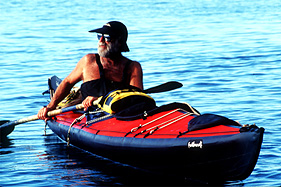
By Richard Roshon, Lecturer, Author, Kayak Entrepreneur Established 1975
A COLLECTION OF ARTICLES
From Kayak, Ocean Habitat is Obviously on Decline - SANCTUARYBy Richard Roshon The following article was published in the Maui News, Hawaii 5/19/97 With all the pros and cons in reference to the proposed Humpback Whale Marine Sanctuary, here in Hawaii, I wonder if anyone truly has taken the time to look up the meaning of "Sanctuary", before it too, like so many other words in our vocabulary lose their meaning and become extinct. There are few people that place the importance and the "being" with Nature ahead of their own well being, as I have for the past 25 years. There are few, if any that have spent more than two decades living with Nature, the Sea and Whales as I have, from an ocean kayak. Until one has spent thousands of hours with nature, in Natures way, can anyone truly understand the meaning of "Sanctuary". Recently, Hawaii was given the lowest marks in the country pertaining to environmental concerns. Ironic, Hawaii contains more indigenous species than anywhere else in the world. The only known place in the world that compares to the fragile ecosystems of Hawaii is the island of Madagascar, which lies off the East Coast of South Africa. I have thoroughly read both volumes of the Environmental Impact Statement Management Plan for the state of Hawaii by the Federal/State Partnership for the Protection of Humpback Whales & Their Habitat. It states, "Things will only get worse. Over population, tourism and uses of the Marine Environment will continue to increase". On March 20, 1997 I had spent the night in my kayak drifting several miles off the coast of West Maui. A very peaceful existence surrounded by only the sounds of Nature. By early morning boats departing from the harbors of Lahaina, and Maalaea could be heard miles away. For several continuous hours helicopters hovered over separate pods of whales. Between boats, planes and helicopters I had not one full minute of silence in 5 hours. Whales have definitely moved further offshore. There is no comparison as to the once frequent sightings of whale's of which I grew up with living on board a sailboat over 50 years ago. Frequent offshore sightings have become extinct. Last year I was asked to speak at the local high school here in Lahaina, Maui. It was difficult, nearly impossible to explain the change that has occurred in the past 20 years, not alone 50 years. Students looked at me in disbelief. Building to close to the shoreline, causes muddy waters after rainstorms. There is nothing to hold the land back from flowing into the sea. Much of the vegetation has been taken away. Cancerous sores on Green Sea Turtles are frequent. And a migration of Humpback Whales to this pristine, isolated island chain of Hawaii has been radically disrupted. Continuous noise from thrill craft (jet skis and parasail operations) that were allowed to run during the winter months throughout the 1980's definitely played a great roll in the migration of the North Pacific Whale. Today they have been banned from Dec. 15th through May 15th. The damage has been done. FACT:
WORLD
WIDE
Convinced that North Africans had crossed the Atlantic to the New World more than 20 centuries before Columbus or the Vikings, Thor Heyerdahl in 1970 crossed the Atlantic from Morocco to Barbados. A 57-day voyage in a boat made of papyrus reeds. From his journal: "The crew had been shocked by all the filth floating in the water. Crewmember, Madani took the daily task of collecting samples of the pollution, so that the sad condition of our sea could be brought to the attention of the world. Into Madani's net fell black wads of oil, bottles, plastic in all shapes, and aerosol cans". I personally have made many Trans-Pacific sailing voyages to the mainland from Hawaii. It is a frequent occurrence to see garbage, thousands of miles from the nearest land. On one such occasion we sailed into a current that contained plastic bottles and other debris. For five hours we plowed through garbage. When kayaking between the Hawaiian Islands of Maui, Molokai, and Lanai I frequently pick up plastic bags, bottles, cigarette butts, fast food wrappers and nets. In 1968, 48 million tons of solid wastes were carried by barge and ship and dumped in the water off the United States. We are only one species out of 30 million, yet modern man will be responsible for the elimination of more species by the year 2000 than have been made extinct in more than 200 million years.
HE WAI WAI NUI KE OLA -- ALL LIFE IS OF GREAT VALUE Back to Articles Back to the top |
 Observations from my ocean kayak this past winter of 1996-97 have been
horrifying. Along with obnoxious high-speed whale watching boats, there
is a new so-called unconscious breed of whale research people, riding
the high seas on obnoxious large boats. Several times I have observed
their practice of literally trapping a whale between a reef and themselves,
keeping the whale from the returning to the open seas. For observation?
Or to see how one can stress out a species?
Observations from my ocean kayak this past winter of 1996-97 have been
horrifying. Along with obnoxious high-speed whale watching boats, there
is a new so-called unconscious breed of whale research people, riding
the high seas on obnoxious large boats. Several times I have observed
their practice of literally trapping a whale between a reef and themselves,
keeping the whale from the returning to the open seas. For observation?
Or to see how one can stress out a species?  This Site hosted by
This Site hosted by